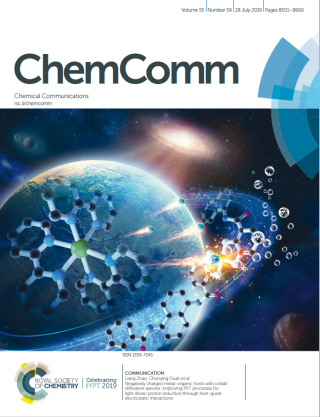Date:Nov 21, 2019
Professor Duan Chunying and Associate Professor Zhao Liang, from the Supramolecular Chemistry and Catalysis Team of DUT, have made a series of innovative achievements in the fields of controlling electron transfer process through the controllable construction of metal-organic supramolecular architectures, which achieved important breakthroughs in matching of the spatial and stereo structures, and multi-step reaction series and collaborative catalytic process by the confinement of metal-organic supramolecular architectures (Angew. Chem. Int. Ed., 2017, 56, 8692−8696; Angew. Chem. Int. Ed., 2017, 56, 15284−15288). By virtue of hydrogen bonds and other supramolecular forces, an innovative idea is proposed to realize the dynamic series connection of multi-step reactions using common intermediates and multiple catalytic units simultaneously, which reveal the structure-activity relationship of metal-organic confined architectures and important guiding value for the development of multi-step catalytic reaction series to practical goal. These researches were reviewed in Coordination Chemistry Reviews (Coord. Chem. Rev., 2019, 378, 151−187). Recently, the Duan group has successfully designed and assembled two new negatively charged metal-organic supramolecular architectures by introducing the cobalt dithiolene compounds as the catalytic center for proton reduction. These supramolecular hosts combine positively charged ruthenium compounds around the catalytic center of cobalt cores through the cooperation of electrostatic interactions and multiple hydrogen bonds, so as to shorten the distance between the photosensitive and catalysis for efficient catalysis. Relevant research result published in Chem. Commun., 2019, 55, 8524−8527, and selected as a cover article for key promotion.

Based on previous research, the Duan group pioneered the work to introduce coenzyme active center into the metal-organic supramolecular confined architectures, and prepared a supramolecular flask for the hydrogenation process with switchable selectivity. The natural cofactors not only transfer protons and electrons in conjunction with different reactions, but also reduce hydrogen donors with double electrons. Through elaborate design to install the active center of coenzyme on the surface of the metal-organic supramolecular flask for transferring the protons and electrons inside and outside the cavity of the supramolecular flask, the Duan group proposed a selectivity-switched hydrogenation strategy, i.e. regulating double electron hydrogenation pathway and single electron hydrogenation pathway. The pre-organization of the substrate within supramolecular flask, the typical double electron hydrogenation is promoted in the cavity of the supramolecular flask, which has high selectivity for aldehydes, ketones and imines. However, the single electron hydrogenation takes place outside the flask cavity and has high selectivity for nitro group. Through the confinement effect of metal-organic supramolecular flask, different electron transfer pathways are controlled inside and outside of the flask cavity without mutual interference. At the same time, by changing the concentration of the substrate and selecting the electron donors with different redox ability, the reaction kinetics of the two hydrogenation routes can be adjusted to switch selectivity of hydrogenation. This kind of supramolecular flask shows excellent performance for the hydrogenation with switchable selectivity. And the hydrogenation selectivity of different groups can reach more than 80%, and it can be directly applied to the one-step synthesis of cinnarizine and naftifine. In view of its simple regulation method and excellent performance, this method is expected to provide technical innovation for the selective preparation of drug molecules. This achievement was recently published in J. Am. Chem. Soc., 2019, 141, 12707−12716.
These work were supported by key project, innovative groups and international (regional) cooperation and exchange project of the National Natural Science Foundation of China and Dalian University of Technology.